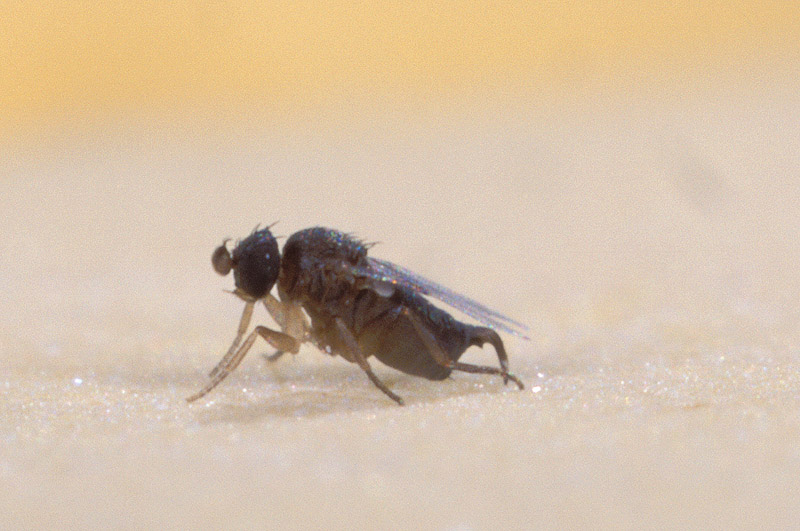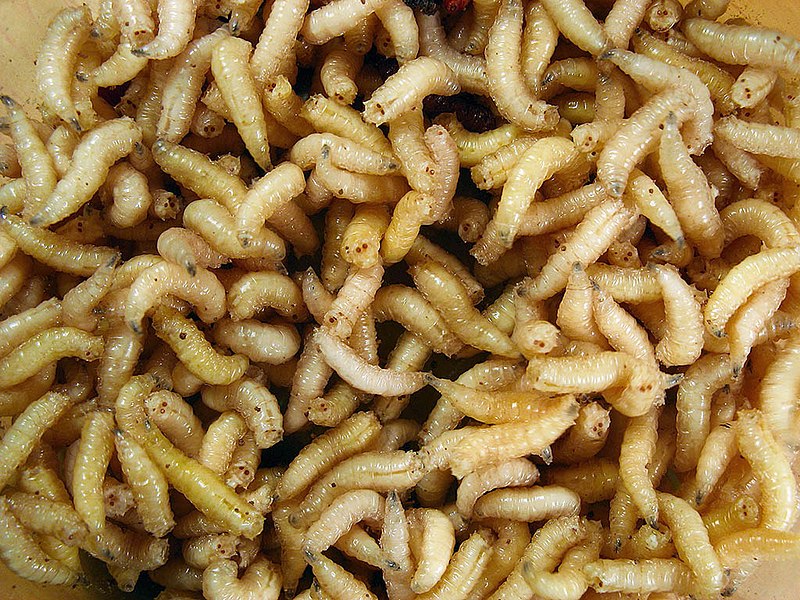
Category Archives: Reptile and Amphibian Health
Feed SubscriptionPhorid or Scuttle Flies – A Common Pest in Herp and Invertebrate Collections – Part 1
 Reptile, Amphibian, Tarantula and Scorpion owners often ask me how to rid their terrariums and homes of the “Fruit Fly” hoards that crop up from time to time. Those keeping carnivorous pets are rightly confused, since fruit is never on the menu, yet the flies persist. Usually, the culprit turns out to be annoying little beast known as the Phorid Fly (a/k/a Scuttle or Humpbacked Fly). The species most commonly seen in the USA is Megacelia scalaris, but some 4,000+ other members of the insect family Phoridae plague pets and people the world over.
Reptile, Amphibian, Tarantula and Scorpion owners often ask me how to rid their terrariums and homes of the “Fruit Fly” hoards that crop up from time to time. Those keeping carnivorous pets are rightly confused, since fruit is never on the menu, yet the flies persist. Usually, the culprit turns out to be annoying little beast known as the Phorid Fly (a/k/a Scuttle or Humpbacked Fly). The species most commonly seen in the USA is Megacelia scalaris, but some 4,000+ other members of the insect family Phoridae plague pets and people the world over.
Description and Life History
Phorid Flies do indeed resemble Fruit Flies, but a close inspection will reveal them to be lighter in color (tending towards grey), more prone to running (“scuttling”) than flying, and without the Fruit Flies’ red eyes.
Like Fruit Flies, if there is food, they will appear, no matter what precautions are taken (it really is amazing how quickly they “materialize” when even the tiniest food source is available). They are very common in cricket-rearing facilities, and frequently hitch a ride to a new home along with this common food item.
Unlike their sweet-toothed cousins, however, Phorid Flies and their larvae (or maggots) are scavengers, feeding upon dead insects, feces, eggs and necrotic flesh associated with wounds.
Potential Problems
 While Phorid Flies have not been known to injure healthy herps or invertebrates, in addition to being a plain nuisance they can colonize wounds, where they may cause complications. Their maggots also commonly appear inside dead or infertile reptile eggs. This puzzled me until it was discovered me (not by me!) that the flies lay their own eggs on the shells of reptile eggs – the hatchling maggots are so tiny that they actually enter the egg via the air pores in the shell! It’s not known whether they attack healthy eggs, but it is not likely.
While Phorid Flies have not been known to injure healthy herps or invertebrates, in addition to being a plain nuisance they can colonize wounds, where they may cause complications. Their maggots also commonly appear inside dead or infertile reptile eggs. This puzzled me until it was discovered me (not by me!) that the flies lay their own eggs on the shells of reptile eggs – the hatchling maggots are so tiny that they actually enter the egg via the air pores in the shell! It’s not known whether they attack healthy eggs, but it is not likely.
Studies at zoos have revealed that Cockroaches, Mice, House Flies and other pests can spread harmful micro-organisms and diseases from cage to cage. Research is needed regarding Phorid Flies, but considering their tiny size it is useful to keep this possibility in mind.
Further Reading
Further information on the control and habits of Phorid Flies and related species here.
Phorid Fly Maggots image referenced from wikipedia and originally posted by Dalius Baranauskas (Dalius 1000)
Reptile and Amphibian Shelters – Choosing the Best Location
While the importance of providing a shelter for pet herps is well-known, the question of where to place the shelter is often not given adequate consideration. In both zoo exhibits and home terrariums, I have noticed that animals sometimes refuse to enter perfectly suitable shelters. Studies carried out at the University of Sydney have recently shed some light on the factors that influence shelter choice in lizards.
Safety vs. Warmth
Writing in the journal Behavioral Ecology (21:72-77), researchers report that Velvet Geckos (Oedura leseurii) avoided shelters that carried the scent of their predators (in this case, Broad-Headed and Small-Eyed Snakes). The geckos refused to enter the shelters despite the fact that they represented the only warm areas within the enclosures, choosing instead to hide in cold shelters. When the cold shelters were also scented, the geckos remained in the open. The experiment was repeated in the geckos’ natural habitat, with the same results.
Practical Applications for Pet Owners
While this behavior might seem to “make sense” to us, I think it is important to bear in mind that hiding from predators and thermo-regulating are key aspects of reptile and amphibian survival. Remaining in the open is very stressful for most species, and may lead to illness and death. Similarly, the failure to maintain the correct body temperature is a direct threat to their survival.
Other Considerations
 While we do not (hopefully!) house our pets with their predators, other factors may be at work. For example, I have found that many animals will remain in a shelter even if the temperature within is too hot or too cold – safety trumping thermo-regulation in these cases.
While we do not (hopefully!) house our pets with their predators, other factors may be at work. For example, I have found that many animals will remain in a shelter even if the temperature within is too hot or too cold – safety trumping thermo-regulation in these cases.
Also, dominant tank-mates may prevent others from using shelters or basking sites, or cause them to remain within shelters for extended periods (thereby affecting feeding and basking behavior). This can occur even in the absence of actual aggression – the mere presence of a dominant animal is often enough to influence the behavior of other animals.
Where highly territorial, visually-oriented animals are concerned, a dominant individual can cause stress just by being within the view of another animal, even if housed in a different terrarium. I have observed this to occur among both chameleons and monitor lizards.
Further Reading
Turtles need shelters other than their shells! Please see my article on Turtle Shelters.
Please see this Herpetologica article abstract for information on other factors that influence shelter choice.
Thanks, until next time,
Frank Indiviglio
Lesueur’s Velvet Geko from Sydney image referenced from wikipedia and originally posted by Hexasoft
Egg Retention (Dystocia) in Turtles – the Problem and Some Solutions – Part 2
 Please see Part 1 of this article for general information on retained-egg syndrome and the provision of suitable nest sites for captive turtles.
Please see Part 1 of this article for general information on retained-egg syndrome and the provision of suitable nest sites for captive turtles.
Creating an Acceptable Nest Site
Gravid turtles can be maddeningly choosy when it comes to nest site selection – even when presented with what appears to be perfectly “natural” situation, some females refuse to “appreciate” our efforts.
Moisture usually attracts nesting females, and in some cases heavy misting, to simulate rain, is useful (in NYC, I’ve noticed that a great many Common Snapping Turtles nest on the first rainy night in June). Read More »
Amphibian News – Bacteria Offers Immunity against Deadly Chytrid Fungus
 A bacterium that naturally occurs on the skin of certain frogs and salamanders has been shown to protect these animals from infection by a deadly Chytrid fungus infection. Chytrid fungus, known as Batrachochytrium dendrobatidis, has been very much in the news since its discovery in 1999. It is believed to have caused the extinction of up to 200 amphibian species, and is still spreading in many countries. Read More »
A bacterium that naturally occurs on the skin of certain frogs and salamanders has been shown to protect these animals from infection by a deadly Chytrid fungus infection. Chytrid fungus, known as Batrachochytrium dendrobatidis, has been very much in the news since its discovery in 1999. It is believed to have caused the extinction of up to 200 amphibian species, and is still spreading in many countries. Read More »
 That Reptile Blog – Reptile, Amphibian and Exotic Pet Care and Information
That Reptile Blog – Reptile, Amphibian and Exotic Pet Care and Information
